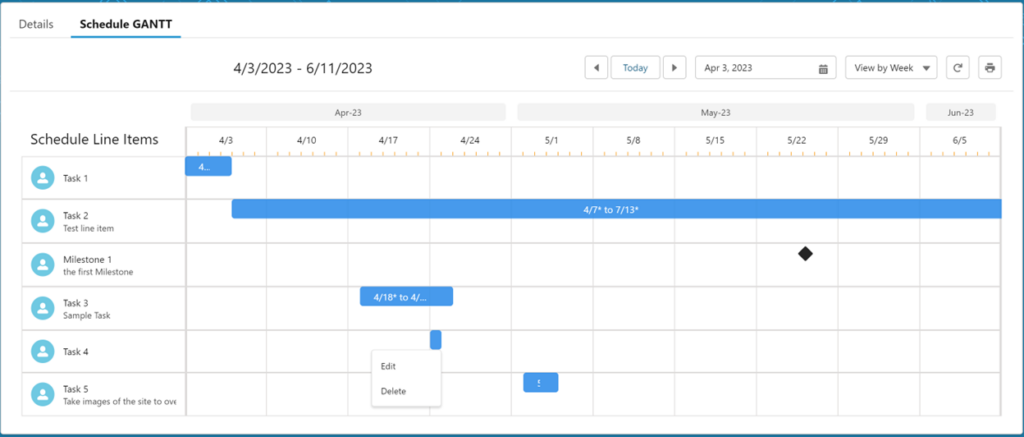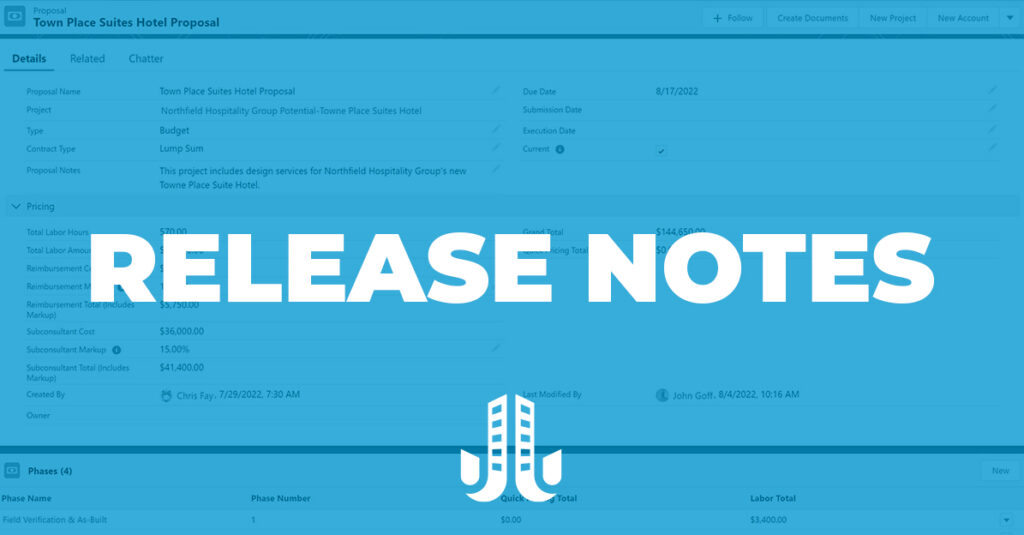We’re excited to announce the latest release of TrebleHook version 2.2, our innovative AEC CRM and project pursuit platform. This new release is designed to enhance and expand upon the existing features of the TrebleHook platform, incorporating your feedback and suggestions to make data management and analysis even easier and more efficient.
TrebleHook version 2.2 includes several exciting new features and improvements that benefit our users. Among these new features are:
- A new Gantt-style chart that updates based on the scheduling line items entered by the user
- Scheduling enhancements include the ability to calculate the third item when two are entered, linking tasks to predecessors or successors, and two types of schedule line items: Tasks and Milestones
- Advanced Inline Editing streamlines the process of updating and managing data within the platform
- And more!
In this feature list, we’ll provide an overview of these key features and other improvements included in this latest release of TrebleHook, and explain how they can help you to work more efficiently and effectively with your data, projects, and pursuits.
Key Features
Quick Links
- Schedules – Gantt Charts
- Schedule Line Items
- Advanced Inline Editing
- Submit for Startup Template
- Knowledge Base
- SF330 Selection Tool
- New Standard Fields
Schedules – Gantt Charts

The scheduling object has been enhanced by adding a new Gantt-style chart. This chart dynamically updates based on the scheduling line items entered by the user, providing a clear and visual representation of the timeline. Additionally, the Gantt chart can be easily printed or exported as a PNG file for use in other documents.
The Gantt chart feature allows users to:
- Enter the edit function of a schedule line item directly from the chart.
- View the chart by day, week, or a six-month or 18-month time frame.
- Print or export the chart as a PNG file for use in other documents.
Schedule Line Items
The scheduling feature has been enhanced with the following:
- Users can now enter any two of the following items (Estimated Start Date, Estimated End Date, and Estimated Duration), and the system will automatically calculate the third item.
- Schedule tasks can now be linked to a predecessor or a successor line item for better organization and tracking.
- Two types of schedule line items are now available: Tasks and Milestones. These items are represented by different icons on the Gantt chart, with Milestones indicating a significant event or goal without a duration.
Advanced Inline Editing
The release includes an advanced inline editing feature that allows users to edit line items in a familiar spreadsheet layout. Previously, users had to open the record page to edit a line item in a related list. With this enhancement, values can be edited directly on the page, as long as the field is visible on the related list. Note that this feature does not support editing locked or formula fields.
This feature is customizable and can be configured to:
- Allow or disallow the creation of new items.
- Allow or disallow the deletion of items.
- Define which record types can be created from this item.
- Customize the name displayed for the related list.
The advanced inline editing feature is currently used out of the box for Phase Line Items and Schedule Line Items in TrebleHook, but it can also be customized for use with other related list views.
Submit for Startup Template
The release includes the “Submit For Startup” template, which consists of an email template and an email alert that can be configured to notify stakeholders about the project startup process. The template is customizable to meet the specific needs of the customer.
Knowledge Base
The release introduces the Knowledge Base, a new object designed to serve as a catalog and repository for various documents that help users learn and use the system, such as FAQs, how-tos, and instructions. The Knowledge Base is versatile and can hold different types of documents or point towards a document or video hosted elsewhere.
SF330 Selection Tool
The release includes the SF330 Selection Tool, a visual interface that enables the scrolling and selection of SF 330 codes to be assigned to a project.
New Standard Fields
Accounts
| Project Management Account ID | External ID field to integrate to a PM system |
| Legacy Account ID | External ID to leverage when migrating data from a legacy system |
| ERP Account ID | External ID field to integrate to an ERP system |
Contacts
| Project Management Contact ID | External ID field to integrate to a PM system |
| Legacy Contact ID | External ID to leverage when migrating data from a legacy system |
| ERP Contact ID | External ID field to integrate to an ERP system |
| Designations | Used to hold professional or other designations (i.e. AIA, LEED, PE, etc.) |
Projects
| Submitted for Startup | The date that project is moved to stage Submit to Startup |
| Project Management Project ID | External ID field to integrate to a PM system |
| Project Address | New Address Field using the recently released Address field type. Replaces the previous project address fields. |
| Legacy Project ID | External ID to leverage when migrating data from a legacy system |
| ERP Project ID | External ID field to integrate to an ERP system |
| Date Project Won | The date the project stage was moved to Won. |
| Client Billing Address | New Address Field using the recently released Address field type. Replaces the previous client address fields. |
| Win % | Replaces the prior Win % field and is now a customizable picklist to ensure users use the proper values. |
| Go % | Replaces the prior Go % field and is now a customizable picklist to ensure users use the proper values. |
Phase
| Project | Lookup field to make it easier to navigate back to the project record. |
Phase Line Item
| Total (Includes Markup) | Replaces the previous Total field to work with the new Advanced Inline Editing. |
| Subtotal | Replaces the previous Subtotal field to work with the new Advanced Inline Editing. |
| Subconsultant Name | Lookup to the record for the Subconsultant |
| Subconsultant Fee | Currency field to hold the fee amount of a subconsultant’s work. |
| Reimbursable Amount | Currancy field for the amount of a reimbursable that is used as a line item. |
| Labor Lump Sum | Currency field used for a lump sum labor amount on a line item. |
| Hours | Number field for the number of hours used in that line item. |
| Billing Rate Schedule | Lookup to the billing rate schedule used |
| Contact | Lookup to the contact used for a line item |
Schedule
| Type | Picklist field to denote what type of schedule it is. |
| Estimated Start Date | The earliest estimated start date based on the schedule line items. Updated dynamically as schedule line items are changed. |
| Estimated End Date | The last estimated end date based on the schedule line items. Updated dynamically as schedule line items are changed. |
| Actual Start Date | The earliest actual start date based on schedule line items. Updated dynamically as schedule line items are changed. |
| Actual End Date | The last actual start date based on the schedule line items. Updated dynamically as schedule line items are changed. |
Schedule Line Item
| Type | Picklist field to identify if the task is a Task, Milestone, or Phase. |
| Total Duration | The number of days between the actual start date and actual end date. |
| Responsible Company | The company that may be responsible for this line item. |
| Remaining Duration | The number of days remaining between the current date and the estimated end date. |
| Estimated Start Date | Date field for the estimated start date of a schedule line item. |
| Estimated End Date | Date field for the estimated end date of a schedule line item. |
| Estimated Duration | The number of days between the estimated start date and end date. |
| Cost | Schedule Line Item |
| Assigned TrebleHook user | Lookup to the TrebleHook user that a schedule line item may be assigned to. |
| Actual Start Date | Date field for the actual start date of a schedule line item |
| Actual End Date | Date field for the actual end date of a schedule line item |
